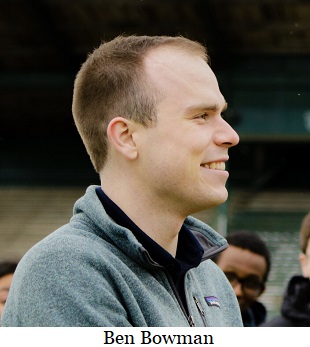 Post an Event
Post an Event
| Benton County Republicans’ Private Fundraising Event, “Bent-on Boots and Bling” with Trey Taylor |
| Friday, September 5, 2025 at 5:00 pm |
| Featuring Trey Taylor
Music Private Event
Friday, September 5, 2025 5:00-5:30 pm VIP Reception
5:30-8:00 pm Heavy Appetizers,
Auction, Concert
Red: $750 VIP Reception
Front Row Table Sponsor
White: $500 Table Sponsor
Blue: $50 per person
Limited Seating. Get Yours Now!!!
Support Local
Dress up: Bling, Cowboy, Patriotic Benton County Republican
FUNDRAISER
www.BentonGOP.org
Get your tickets today at:
https://www.bentongop.org/event-details/benton-county-republicans-fundraiser/form
About Trey:
Trey is the youngest African American Man in Country Music History. The Denver Post wrote
"It's impossible to miss his enthusiasm. With a fondness for cowboy boots, gaudy colors and dazzling jewelry, Trey Taylor could stand toe to toe with any of the Pop, Country or even Rap
contemporaries of his generation.“ |
| Trysting Tree Golf Club, 34028 NE Electric Rd., Corvallis |
Oregon Health Authority is not stepping up to the plate
The U.S. Court of Appeals for the
Ninth Circuit ruled June 5 that a lawsuit brought by four hospital systems against the Oregon Health Authority (OHA) was wrongfully dismissed.
Legacy Health, PeaceHealth, Providence Health & Services, and St. Charles Health System filed the lawsuit in September 2022 because the OHA is failing to fulfill its duty to provide adequate access to care for people experiencing severe mental illness. With today’s ruling, the case now returns to the United States District Court for the District of Oregon, where it can continue through the legal process.
The appellate court heard oral arguments on May 8 in Seattle. In the oral arguments, counsel for OHA conceded that the lack of resources for civilly committed individuals is a “long standing, challenging problem that Oregon faces.” Ninth Circuit Judge William Fletcher responded that “it’s a challenge because Oregon is not stepping up to the plate.” In the argument, counsel for OHA further conceded that it has an obligation to make to an appropriate placement of civilly committed persons.
Over two years after this case was filed, legislators passed
HB 4002, which removes barriers and establishes programs and policies aimed at improving access to substance use disorder (SUD) treatment. It also establishes a criminal justice framework for possession or delivery of controlled substances designed to encourage treatment over penalties such as jail or probation. Legislative days this past week discussed the enforcement portion of the legislation. To date it is unclear what OHA has done to establish what the bill requires to help behavioral health issues and establish a certified community behavioral health clinic (CCBHC) program located in same geographic region as community mental health program (CMHP) to enter into collaboration agreements.
Governor Kotek also seems to be ignoring the
OHA report released earlier this year, which admits that there is a severe shortage of capacity needed to treat individuals in need of both acute and long-term behavioral health treatment across Oregon. Along with the lawsuit and HB 4002, Kotek should answer to why there is a lack of access to behavioral health units for individuals experiencing an acute mental health crisis.
Melissa Eckstein, President, Unity Center for Behavioral Health said, “We’re pleased with the court’s decision, and we’re optimistic that this lawsuit will result in a much-needed course correction from the OHA. We originally took this action because the State of Oregon consistently violates the civil rights of vulnerable Oregonians by refusing to provide care intended to restore their freedom.”
Combined, the four hospital organizations operate more than half of the state’s psychiatric beds, which are designed only for short-term acute care. However, civilly committed patients in need of long-term treatment are not being transferred from the hospitals to more appropriate facilities as the law requires. Instead, many of these patients are forced to remain for weeks, months or longer in highly restrictive acute care settings without a treatment plan tailored to meet their mental health care needs.
A D V E R T I S E M E N T

A D V E R T I S E M E N T
“Community hospitals are not equipped, staffed or designed to provide long-term mental health care,” said Alicia Beymer, Chief Administrative Officer, PeaceHealth Sacred Heart Medical Center at RiverBend. “Despite the previous dismissal of our case, we felt duty-bound to appeal on behalf of the many vulnerable patients who are being denied appropriate care.”
“The court’s ruling allows us to continue pursuing legal action to ensure that there is a functional mental health system in Oregon,” said Robin Henderson, Chief Executive, Providence Behavioral Health. “Such a system and continuum of care must include secure residential treatment facilities, as well as effective community-based services to meet the various needs of this vulnerable patient population. Oregonians won’t be able to fully realize this system until the state begins living up to its legally mandated role.”
Is government the cause, the solution, or in the way?
--Donna Bleiler| Post Date: 2024-06-07 11:26:26 | Last Update: 2024-06-07 23:31:55 |
Calls Hoyle’s Rubberstamping Biden Border Invasion While Defunding Veterans’ Healthcare “Thoroughly Egregious"
Republican candidate for
Oregon's 4th Congressional seat Monique DeSpain responded to Val Hoyle’s
vote opposing
HR 8580, which would fund Veterans Affairs and critical military programs while ending the current use of the Veteran Administration to pay for free healthcare for illegal migrants.
“Today, Val Hoyle chose partisan politics and illegal migrants over our precious military veterans to whom our nation owes so much,” stated DeSpain. “As a veteran and a retired Air Force Colonel who is deeply concerned by the clear and present national security crisis at the border, I am appalled by Val Hoyle’s thoroughly egregious vote to greenlight the Biden Administration’s looting of VA resources to pay for the chaotic border invasion that President Biden caused, and Congresswoman Hoyle repeatedly enabled.”
In her first term as our Representative, Val Hoyle has
voted against fully funding veterans’ health care and benefits and
voted to block pay raises for active-duty military personnel in July 2023. Earlier this year, Val Hoyle went to El Paso, TX, and
praised open borders while lecturing her constituents who asked her, “Why don’t you just shut down the border?” explaining that
“We need to have movement through the border and how much we need the workforce.” Seven weeks later, Texas National Guard Troops at an El Paso, TX checkpoint were overrun and assaulted by foreign military-aged males forcing their way into our country. These are the people Val wants to allow access to our limited veteran resources. In a slap to law enforcement, Hoyle recently voted against H.R.7343, the Detain and Deport Illegal Aliens Who Assault Cops Act. Last week, the Democratic Congressional Campaign Committee moved Val Hoyle to its “frontline” list of vulnerable incumbents.
“After spending her entire time in Congress voting against any effort to hold the Biden Administration accountable for its catastrophic border policy and even lecturing her constituents that we ‘need this movement through the border,’ now she has voted to take resources Congress reserved for veterans, and instead she wants to fund free healthcare for illegal migrants invited by President Biden’s border policy,” said DeSpain.
A D V E R T I S E M E N T

A D V E R T I S E M E N T
“However, Val’s vote is worse than rubberstamping bad behavior by the Biden Administration. It is a real stab in the backs of my veteran brothers and sisters waiting to access often unreasonably delayed health treatments to which they are entitled - a dereliction of duty to our veteran constituents,” added DeSpain. “Our veterans and active duty should be at the top of our priority list, but Val has put them at the back of the line. They won’t forget. Neither will I, nor will the voters.”
“Val has cast numerous shocking votes at the expense of the citizens of our district, which has exposed who her true priority is - her radical special interest ‘open borders’ masters in Washington D.C.,” said DeSpain. “Now Val’s gone too far by victimizing our veterans. Blatantly corrupt, self-serving, hyperpartisan career politician Val Hoyle is at the heart of the dysfunction in our Nation’s Capitol. Perhaps it’s no surprise that her party bosses have put her on the list of incumbents most in jeopardy of defeat in 2024.”
“As a retired Air Force Colonel and lawyer, I know what fighting for our country and our communities looks like,” said DeSpain. “I am ready to deploy to Congress to make sure my 53,000 fellow 4th District veterans are the priority while still securing our borders by all means necessary and ending the public safety crisis of fentanyl, meth, human smuggling, and crime gripping the 4th District. It all starts with retiring Val Hoyle this November.”
--Staff Reports| Post Date: 2024-06-06 19:32:43 | Last Update: 2024-06-06 19:54:44 |
Prohibition of nudity is left to local ordinances
Oregon made national news again – and not in a good way. A disturbing incident in Oregon has raised concerns about public indecency laws. A video of a father’s interaction with a Bend police officer went viral on social media after the man complained about a naked man approaching his 2-year-old son and the officer informed him it was legal.
The father shielded his child’s eyes and called 911, expecting swift action against the individual for indecent exposure. However, the responding officer surprised him by stating it is only a crime for an adult to expose his or her private parts to a minor when there is a sexual element to the act. But there is no law against the actual nudity exposure.
The
video on tiktok shows a father asking officer Jeremy Avery with the Bend Police Department to explain why an arrest could not be made after his young child encountered a naked adult on the family’s private property.
The post has over 800,000 views waking people up to how the “letter of the law” is used to give freedom to perversion, but is ignored when people deserve freedom of speech and religion. Many replies asked who determines what gratification is.
Oregon law regarding naked exposure is outlined in ORS 163.465, which states that a person commits the crime of public indecency if, while in or in view of a public place, they perform an act that is intended to arouse or satisfy the sexual desire of any person. Indecent exposure is a Class A misdemeanor punishable by up to one year in jail and a fine of up to $6,250.
What is considered public indecency? According to ORS 163.465, public indecency includes:
- Exposing one’s genitals with the intent to arouse or satisfy the sexual desire of any person.
- Performing an act of sexual intercourse in a public place.
- Engaging in any other act of sexual conduct in a public place.
A D V E R T I S E M E N T

A D V E R T I S E M E N T
While Oregon law does not explicitly prohibit public nudity, some cities and counties in Oregon have established their own laws regarding public nudity. Ordinances have been adopted, for example: Portland has a law that prohibits indecent exposure, which includes exposing one’s genitals in a public place. Lane County has a law that prohibits public nudity, except for certain events and activities that are specifically permitted.
Portland and Lane County have had incidents in the passed to instigate an ordinance. The wider the incidents the more likely state legislators will propose a law. Officer Jeremy Avery did concede that trespassing was a crime in Bend, although public nakedness was not.
--Donna Bleiler| Post Date: 2024-06-06 16:57:15 | Last Update: 2024-06-06 18:11:22 |
Small doctor-owned clinics are being bought up by large corporations and private equity firms
Oregon Representative Ben Bowman (D-Tualatin) participated on a panel at a Salem City Club event about the rapid trend of corporations and private equity firms acquiring local medical practices. He writes, “In the last 10 years, there has been a
100,000% increase in private capital invested into primary care. The scale of that increase alone should give us all pause.”
Bowman reports, “Across our state and the country at large, small doctor-owned clinics are being bought up by large corporations and private equity firms. When you replace a locally-based physician owner with a private equity firm there are serious, negative consequences. Prices go up, quality of care declines, injuries increase, and physicians burn out. In short, worse care at higher prices.
We are seeing the harm of not acting in real-time.”
Bloomberg writer, Angelica Peebles, says, “Several large companies are also making a push towards primary care in an effort to control access to more expensive specialists and influence patients' treatments over time. For example, CVS Health plans to put doctors in up to 350 of its retail pharmacies…Walgreens Boots Alliance last year purchased a controlling stake in the primary care clinic chain VillageMD, which it previously partnered with to open new primary care clinics across the United States…health insurers are expanding their primary care capacities. UnitedHealth Group's Optum unit now has more than 60,000 physicians, around half of whom are in primary care… Humana plans to open 26 new primary clinics under its CenterWell brand this year and will add between 30 to 50 more annually.
According to Peebles, this interest in primary care is partly motivated by a shift in how medical care is paid for. Private health plans, as well as government programs like Medicare, are increasingly turning towards value-based payment, which links doctors' pay to patients' health outcomes, rather than volume-based payment. This change may increase the risk that profit motivation could eventually outweigh patients' best interests.
Bowman wants to bring legislation in 2025 that will address this growing problem. He sites thousands of patients in Eugene received letters informing them that their local clinic, the Oregon Medical Group, could no longer provide care for them. They would have to find a new doctor.
Independent Health News reports that UnitedHealth’s vehicle for growth – and more profits – is its Optum Health division. Observers say the consolidation could improve the quality of care — or lead to higher prices as the corporate owners exploit their greater control.
Since the purchase of Oregon Medical Group, close to 30 physicians have left the clinic and, due to the contracts they signed with United Health, were forced to either retire from the practice of medicine or leave the community they had made their home. Those leaving the clinic reported that UnitedHealth’s focus on efficiency and profit left them feeling disillusioned and unable to provide the best care for their patients.
Bowman also reports that Oregon’s Coordinated Care Organizations (CCO), are having very important and very-under-the-radar conversation going on around the Oregon Health Plan and CCO’s model serving Medicaid population. The goal of Oregon’s CCO model is to provide a coordinated service delivery model to promote physical, behavioral, and oral health.
CCO’s were established in 2012 and is thought to have bent the cost curve. The second round of “procurement” in 2020, CCOs were given contracts and performance metrics setting the goals for the entities that provide care to low-income families. The behind closed-door meetings are for a third round of procurement. This will likely be the largest procurement process the state has ever done according to Bowman. It involves investing millions of dollars to ensure Oregonians are well cared for, and how it is distributed, and what benchmarks are set for the entities who are awarded contracts.
A D V E R T I S E M E N T

A D V E R T I S E M E N T
Bowman releases his goals for legislation to enact the next procurement process:
- Ensuring every Oregonian has access to a basic level of quality health care.
- Incentivizing upstream investments in health that lower the cost of providing medical care in the long run.
- Providing stability that ensures CCOs are rooted in the communities they serve.
- Providing flexibility so that CCOs are able to innovate and build local partnerships that better serve the needs of the people they serve.
- Ensuring there are clear accountability measures directly connected to the health outcomes of people and populations.
These sound oddly familiar to the Oregon State University
2023 Health Care Workforce Needs Assessment report done in accordance with
HB 3261 for the Oregon Health Authority. It exposed a severe health care crisis and higher than expected, partially from burnout after the pandemic. The report recommended improved support for health care professionals, expand telehealth and integrated care models, and increase the use of community-based care providers like health interpreters and peer wellness specialists to connect on a more personal level with their local communities. Had this report been acted on, would the small doctor-owned clinics been saved?
Since voters passed the right to health care, Governor Kotek hasn’t supported the universal health care board proposed cost of $2 million plan. She says it’s costly and cited potential duplications. Kotek has prioritized behavioral healthcare in response to
HB 4002. Oregonians shouldn’t be surprised that UnitedHealth is positioning their clinics to meet Kotek demands on cost reduction while expanding free care to non-insured non-residents, covered treatment for reproductive care (abortions and transitioning), the need for specialized behavioral health physicians, and the projected CCO procurement process to cover universal healthcare. It all adds up to unsustainable budgets and higher taxes.
--Donna Bleiler| Post Date: 2024-06-03 11:37:59 | Last Update: 2024-06-03 22:56:48 |
A more disciplined approach to the budget would lessen the burden on taxpayers and improve economic stability
Oregon's
June revenue forecast released by the Office of Economic Analysis indicates, despite big surpluses, significant economic challenges are ahead due to stagnant growth and high inflation. Republican leaders call for adopting a more disciplined approach to the state’s finances would help lessen the burden on taxpayers and improve economic stability.
Senate Republican Leader Daniel Bonham (R-The Dalles) said, “Across the state, Oregon families are having to tighten their budgets and make difficult choices as rising costs due to high inflation outpace their earnings. It’s time the state does the same. The latest revenue forecast indicates that the state has continued to take more than enough of our hard-earned tax dollars. The Legislature – like many of our friends and neighbors – must learn to live within its means.”
“As we navigate through this period of high inflation, rising costs, and stagnant growth, our caucus will continue to advocate for budgetary restraint to ensure the long-term viability of essential services. The Oregon Legislature must act. Soaring energy prices are an example of an inflationary pressure we can actually do something about. Through fiscal accountability and responsible spending, Senate Republicans offer policy
solutions that would provide tangible relief to working Oregonians and protect the financial well-being of all Oregon families.”
A D V E R T I S E M E N T

A D V E R T I S E M E N T
Inflation's effect on Oregonians doesn't seem to matter to Governor Tina Kotek. Government greed is the cause for inflation, and Kotek just keeps spending. Recently she proposed a $40 million investment to sustain container service at Port of Portland’s Terminal 6. This includes $35 million from her 2025-2027 budget that includes a $20 million invested into a capital program that supports ports with active container service. It is unclear where this money would go since it appears that Port of Portland Terminal 6 is the primary and could be the only container port in Oregon. The other $15 million will be dedicated to initial state funding for costs associated with the Lower Columbia River Channel Management Plan. However, only $5 million that she is requesting from the legislative Emergency Board will go to directly resolve the shortage at Terminal 6.
Kotek response on the forecast, “Oregon’s economy continues to be stable and productive. We have made meaningful progress on issues of top concern for Oregonians and worked to move our economy in the right direction. I look forward to continuing to partner with the legislature to focus on meeting people’s needs in every part of the state, from housing to safe schools to behavioral health services.”
--Donna Bleiler| Post Date: 2024-05-31 11:03:20 | Last Update: 2024-05-31 01:17:48 |
“Make sure you’ve renewed your registration and put the decals on your boat correctly, or you could face a $265 citation.”
The Oregon State Marine Board, chaired by Laura Jackson, in partnership with 31 county sheriff’s offices and the Oregon State Police, will be looking for expired boat registrations and required equipment compliance on state waterways as part of “Operation Ship Shape.”
“Boat operators are required to have current registration decals on the bow of their boats and carry the Certificate of Number on board,” says Brian Paulsen, Boating Safety Program Manager for the Marine Board. “Make sure you’ve renewed your registration and put the decals on your boat correctly, or you could face a $265 citation.”
Any boat powered by a motor – electric, gas, diesel, and all sailboats 12 feet and longer must be currently registered when on the water, even when docked or moored. This includes any kayaks and drift boats with an electric motor. Paulsen added, “Each current boat registration brings in additional federal funds which go back to boaters for program services.”
Motorboat registrations are valid for two calendar years and expire on December 31st of the second year. The cost for registration is $5.95 per foot rounded up, plus $5.
Paddlers with boats 10 feet and longer must carry a Waterway Access Permit. Three permit options are available: One week for $5, one calendar year for $17, and two calendar years for $30.
A D V E R T I S E M E N T

A D V E R T I S E M E N T
Boaters can renew their registration or purchase Waterway Access Permits through the agency’s Boat Oregon Store for the fastest service. After completing their online transaction, boaters with motorized boats can print off a temporary permit. Waterway Access Permits can be printed directly after purchase. Multiple purchases can be made under one online transaction. The agency’s online store has a $1.50 portal provider fee. If you need assistance online, please contact the Marine Board at marine.board@boat.oregon.gov or call 503-378-8587. There's also an online help page acclimating new users to the store.

Marine officers will also be looking for the required safety equipment. “Life jackets are the most important safety equipment boaters must carry, and there must be enough on board that fit every passenger,” Paulsen adds. “We’ve seen three years of declines in boating fatalities and want this year to be the safest on record. In 2023, 11 out of 13 victims were not wearing a life jacket, so find a life jacket you’ll wear for the type of boating you’re doing.”
For any titling and registration questions, visit
Boat.Oregon.gov and click on the Title & Registration tab at the top of the page.
--Staff Reports| Post Date: 2024-05-30 13:46:46 | Last Update: 2024-05-30 14:00:28 |
A K-9 alerted to the presence of illegal substances
Four Oregon State Police traffic stops along Interstate 5 have yielded significant drug seizures in the last month. Oregon State Troopers seized fentanyl, methamphetamine, PCP, and other illegal drugs bound for Oregon streets. The targeted operations are a collaboration among Oregon State Police patrol, K-9, High Intensity Drug Trafficking Areas Investigation Team, and Criminal Apprehension through Patrol Enforcement programs.
OSP Capt. Kyle Kennedy said, “Oregon State Police is diligently working to stop the flow of illegal drugs to our communities. Fentanyl continues to have devasting effects on Oregon’s communities, and we hope the constant pressure will deter and prevent the transportation of illegal drugs to and through our state.”
On Wednesday, May 8, 2024, at 9:50 a.m., an OSP K-9 trooper stopped a vehicle on I-5 in Linn County for a traffic violation. During contact with the driver, the trooper suspected possible criminal activity. A K-9 was deployed around the outside of the vehicle and alerted to the presence of illegal substances. During a search of the vehicle, the trooper located 10,000 pills suspected to be laced with fentanyl in the vehicle’s trunk.
On May 14, 2024, at 1:13 p.m., an Oregon State Trooper from the Salem Patrol Office stopped a vehicle for a traffic violation on I-5 near milepost 256 in Marion County. During the stop, the trooper observed contraband in the vehicle and suspicious behavior by the vehicle occupants.
During a consent search of the vehicle, the trooper located 4.6 pounds of fentanyl, 1 pound of PCP, 84 grams of suspected methamphetamine, and 14.2 grams of cocaine.
The driver, Edgar Izaguirre Torres (33), whose city of residence is unknown, and the passenger, Marvin Fabian Oseguera Escoto (19) of Auburn, WA, were arrested for distribution of a controlled substance. Once the investigation is complete, additional charges will be referred to the prosecuting agency.
A D V E R T I S E M E N T

A D V E R T I S E M E N T
Oseguera Escoto was additionally arrested on a California warrant for distribution of a controlled substance.
On May 21, 2024, at 8:40 a.m., an OSP K-9 Trooper stopped a vehicle for a traffic violation on I-5 northbound at milepost 148. The trooper contacted the vehicle occupants and noticed signs of criminal activity. The driver and passenger fled from the vehicle on foot. The trooper caught and detained both suspects a short distance from the vehicle.
The K-9 was deployed around the outside of the vehicle and alerted to the presence of illegal substances. A search warrant was granted, and 42,000 suspected fentanyl-laced pills and approximately 8 pounds of fentanyl powder were found inside the vehicle.
The driver, Lauro Parra Moreno (25) of Pittsburgh, CA, was arrested for misdemeanor elude, criminal trespass II, Possession of a controlled substance II, and Delivery of a controlled substance I. The passenger, Jesus Acosta Parra (20), of Pittsburgh, CA, was arrested for criminal trespass II, delivery of a controlled substance II, and possession of a controlled substance II.
The investigation is ongoing, and no further information is available for release at this time.
On May 23, 2024, at approximately 11 a.m., an Oregon State Police K-9 Trooper stopped a vehicle for a traffic violation on I-5 near milepost 225 in Linn County. The vehicle was occupied by an adult couple and their 6-month-old infant.

During a consent search of the vehicle, the trooper located 136 grams (about one-third of a pound) of fentanyl powder and mannitol, which is a common cutting agent for fentanyl. The fentanyl was located in the trunk of the vehicle near the baby’s formula and clothing.
The driver, Meslin Danexi Gamez Barrientos (30) of Oakland, CA, was arrested for possession and delivery of a controlled substance and endangering the welfare of a minor. The passenger, Maryori Estefani Ochoa Chapas (30) of Oakland, CA, was arrested for possession and delivery of a controlled substance and endangering the welfare of a minor.
The infant was placed in protective custody by the Oregon Department of Human Services.
--Staff Reports| Post Date: 2024-05-29 13:16:06 | Last Update: 2024-05-29 13:54:53 |
Best interest means Oregon has a moral and upright standard
Julia Shumway wrote a good article in the
Capital Chronicle on the Primary Republican election results and the shifting of styles. She writes, “No Senate Democrats faced primaries, and control of the chamber isn’t expected to change.” That may be the impression she gets from interviewing the defeated, coupled with a low turnout. But, don't forget, the largest block of voters have yet to weigh in.
The GOP senate is faced with more challenging races only because Democrat Senate president Rob Wagner barred several GOP senators from running for reelection by his biased application of policies – approving leave for Democrats that wasn’t approved for Republicans. Two of them gave notice of retirement.
What seemed to influence her article is political consultant Bryan Iverson, losing his campaign for Rep. Christine Goodwin to Noah Robinson, whom he called an “obstructionist” candidate. Iverson said, “In the Republican primaries, at least in southern Oregon, you see victories by the same hard-right-leaning candidates and not the everyday Republicans.” Maybe his campaign put Goodwin in a devious light, setting up a questionably phony residence, and creating a last-minute pro-gun organization to sway voters was more “obstructionist” than the opponent.
Iverson told
Capital Chronicle, Josephine County – or at least the Republicans in the area who showed up to vote – made it clear they wanted a different style of candidate. “They want that brand of Republicans that are just obstructionist, basically. I think that they were pushing for that from the get-go, and that’s obviously how it turned out. That’s not what Chris wanted to represent, she wanted to represent those people and have a different way of going about it than I think Noah would, but that’s not what the people wanted.”
What Iverson complained about in District 2 certainly wasn’t the case in District 1 – where the “everyday Republicans” carried the status quo vote. David Brock Smith and challenger Todd Vaughn was the most visibly ugly campaign Oregon has seen in a long time. It was started by Brock Smith when he refused to respond to radio host Rob Taylor on his relation with a California donor who has ties to China. The implication angered Brock Smith, and he still hasn’t fully explained his relationship. He was then asked to justify his flip-flopping on the ocean windmill farm proposed off the coast of Coos County. The combination spearheaded an ugly campaign out to destroy each other leaving voters to figure out the truth amidst all the accusations. Brock Smith won by 57% of the vote, but you can be sure voters are watching whether he will flip again and support ocean windmill farms.
Iverson’s “obstructionist” candidate might define Diane Linthicum who beat Klamath County Commissioner Dave Henslee. Henslee seems to think that it’s all about the money. He said of Diane, “She completely supports Dennis Linthicum’s voting record, and in my opinion, his voting record hasn’t benefited our district. I was running for people and for our district, and to try to move the needle and do some really positive things for District 28, and unfortunately, the voters didn’t see it the same way I did.”
Henslee’s view is precisely why the vote for Greater Idaho is now 13 counties strong. They are tired of metro legislators being focused only on their districts and not looking out for the best interest. For the best interest of all Oregon, there needs to be a moral and upright standard for the entire state. In that there is no compromise. Dennis Linthicum would not lower his moral values to compromise even at the threat of his position.
Former House Republican Leader Mike McLane won District 30 to replace retiring Sen. Lynn Findley and is looking forward to meeting with Senator Daniel Bonham and Senate President Rob Wagner on policy decisions. He says, “During my time as a judge, I saw in the courtroom the consequences of policy passed in Salem, and it just shaped in me a view that perfection is often the enemy of the good.” His ultimate goal is to get something that works.
A D V E R T I S E M E N T

A D V E R T I S E M E N T
Todd Nash, Wallowa County Commissioner, won District 29 to replace retiring Sen. Bill Hansell representing northeast Oregon. His plans to meet with natural resource groups including the Oregon Farm Bureau and the Oregon Cattlemen’s Association, may label him as an “obstructionist” according to Iverson. The attack that Democrat leadership is hurling at small farms will affect everyone, and voters can’t afford to ignore.
Other Senate races will have a steep battle against Democrat opponents, but more often than not, “obstructionist” candidates have received more voter attention from nonaffiliates than the status quo. It is the reason they chose not to register with a party. If voters remember that, “obstructionist” candidates will do well.
- District 5: Dick Anderson(R) vs. Jo Beaudreau(D)
- District 12: Bruce Staff (R) vs. Scott Hooper (D)
- District 14: Shane Bolton (R) vs. Kate Lieber (D)
- District 18: Brian Pierson (R) vs. Wlnsvey Campos (D)
- District 22: Michael Saperstein (R ) vs Lew Frederick (D)
- District 25: Raymond Love (R) vs. Chris Gorsek (D)
- District 27: Michael Summers (R) vs. Anthony Broadman (D)
--Donna Bleiler| Post Date: 2024-05-27 19:44:25 | Last Update: 2024-05-27 22:21:35 |
The public is invited to testify at each of the 12 stops
In March, public pushback caused Governor Tina Kotek to tell ODOT to halt tolling plans until January 2026. The Joint Committee on Transportation to the rescue with a plan to appease public opinion, they scheduled 12 meetings throughout the state. They announced that Portland Community College will be the venue for the first meeting of the Transportation Safety and Sustainability Outreach Tour.
"Safe, sustainable, multimodal transportation systems are of critical importance to local, regional, and even international travel and commerce between urban and rural communities," said Rep. Susan McLain (D-Hillsboro, Forest Grove and Cornelius), co-chair of the Joint Committee on Transportation. “We’re working to ensure that all communities, all families, and all businesses are provided with choices that are safe, resilient, and sufficient to meet transportation needs.”
Sen. Chris Gorsek (D-Troutdale), co-chairs of the Joint Committee said, "Each stop on this tour is going to give us a greater perspective of the transportation needs in Oregon and how best to tackle the structural challenges we are facing."
The first public hearing will be held on June 4 from 5 p.m. to 7 p.m. at the Portland Community College Cascade Campus Moriarty Auditorium at 705 N. Killingsworth Street. It will also be available via
livestream. Members of the public interested in testifying can register in person starting 30 minutes before the meeting begins. The committee will also hear remote testimony if time permits, if
registered, and written testimony can be submitted via email to JCT.exhibits@oregonlegislature.gov.
Preceding the meeting, members of the committee will take a guided trip of transportation facilities in the Portland metro area at noon, and hold a roundtable discussion at 2:30 p.m., which will help them understand the transportation needs of that region through the expertise and lived experience of local partners and officials. A full agenda of the day with
registration information.
A D V E R T I S E M E N T

A D V E R T I S E M E N T
The objective of the tour is to gain perspectives and gather information to inform legislators as they develop a plan in the 2025 session to maintain critical infrastructure, complete work on major projects, and guarantee the safety and diversity of transportation systems across the state.
Tour locations and dates (venues to be announced later):
- Downtown Portland - Tuesday, June 4
- Tillamook - Tuesday, June 18
- Albany - Tuesday, July 16
- Eugene - Wednesday, July 17
- Coos Bay - Wednesday, August 7
- Medford - Thursday, August 8
- Ontario - Wednesday, August 28
- Hermiston - Thursday August 29
- Bend - Thursday, September 12
- The Dalles - Friday, September 13
- Happy Valley - Thursday, September 26
- Hillsboro - Friday, September 27
The committee is vice-chaired by Sen. Brian Boquist (R - rural Polk and Yamhill counties) and Rep. Shelly Boshart Davis (R - Albany, Millersburg, and Tangent). The full membership of the committee can be viewed on olis.oregonlegislature.gov.
--Donna Bleiler| Post Date: 2024-05-26 14:47:12 | Last Update: 2024-05-26 16:59:48 |
Cutting DEI could salvage Oregon’s education system
The Oregon Association of Scholars, an affiliate of the National Association of Scholars, released
Issue Brief 13 examining the costs and reach of Diversity, Equity, and Inclusion (DEI) bureaucracies at the three largest public universities in Oregon.
The brief reports that public universities, Oregon State (OSU), Portland State (PSU), and University of Oregon (UO), in 2020 were spending an average of $1.7 million per year in annual costs for salary and benefits for DEI Vice Presidents and an average of 19 full-time staff for each DEI office. The DEI offices for all three universities expanded their investment to a shocking $7,255,758. This has contributed to nearly $3,000 increase in tuition costs for the same period. The brief asks “the question of what the universities, the students, potential employers, and the people of Oregon are getting out of these large investments and the concomitant hyper-intense institutional focus.”
A
Heritage Foundation study measured an average of 4.6 exclusive Diversity, Equity, and Inclusion (DEI) personnel are at major public state universities for every 100 faculty members. The study reported that DEI staff and departments urge students to embrace radical leftwing ideologies, including that people should be treated differently due to their race. The study showed DEI bureaucracies are better understood as an academic version of a political commissariat that articulates and enforces an ideological orthodoxy on campus.
In a U.S. Supreme Court landmark decision in
Muldrow v. City of St. Louis, the ruling chipped away at all DEI-based discrimination. The orthodoxy tends to make many groups of people feel unwelcome, promotes division, and encourages conformity rather than diversity on various social and political issues. Lawyers tried to argue that there is ‘good discrimination’ and ‘bad discrimination’, that white people should be purposely disadvantaged to pave the way for diversity. The lawyers stated that the court's decision will complicate DEI programs and limit their ability to discriminate against white men.
The financial costs are substantial and on their own raise questions of the utility and necessity of the DEI apparatuses, particularly with the high and continually growing costs of college. There are also questions and issues far beyond the financial costs that should cause the public and the universities to seriously consider a need to down-size or eliminate the DEI bureaucracies and its framework. Heritage analysts found that student surveys exposed the worse campus climates they have measured.
The brief states, “As the costs of college tuition continue to grow, mostly unabated, any expense that is not essential to the operation of a university, whether as a research institution or teaching students to develop knowledge and skills in their areas of study, should be heavily scrutinized. The cost of these DEI leviathans is far greater than the financial one. The loss of public trust in institutions, while difficult to quantify, is very real and the bean-counting style fixation on the distribution of identity characteristics in what should be serious institutions of inquiry and scholarship only further erodes public confidence. The level of influence of DEI dogmatism and its champions raises the serious question of if the universities themselves have wandered from the legislatively defined purposes for which they were established.”
The public university system does not exist to pursue partisan political goals or whatever mission a university may wish to adopt. “Our universities, which are supposed to serve as strongholds of rational inquiry, the unapologetic pursuit of truth, and the abrogation of fads, appear to have thrown caution and evidentiary standards to the wind as they repurposed hitherto world-class institutions in furtherance of the dogmas of “Critical Social Justice”.”
There are laws that set their overall mission and goals and the fundamental shift in direction made by DEI ideology does not align with their defined purpose. The brief states that the ideological framework that underlies DEI flows out of Neo-Marxist doctrine of Critical Race Theory (CRT), which is being pushed into K-12 schools, and fundamentally at odds with traditional civil rights discourse and the enlightenment-based ethos which is supposed to be at the heart of the university. It is not possible for a university to simultaneously embrace a framework that calls for fundamental changes to our social and political systems and remain aligned with the goal of creating an educated citizenry that can support responsible roles in a democratic society.
A D V E R T I S E M E N T

A D V E R T I S E M E N T
Additionally the brief states, there is no solid evidentiary basis that DEI implemented at the lowest level through training produces positive results. Some research has shown that they have the opposite effect of what they are advertised to do and actually increase prejudices and social tensions. A fundamental change in institutional direction at a university should be based on firmly established evidence, not untested ideological fads. Oregonian’s have a deep connection to our public universities and these institutions should honor that by returning to their core mission.
The brief concludes that these are public universities which receive taxpayer funding from the people of Oregon while claiming to serve broad, non-sectarian, interests. Alas, it is difficult to see these agendas as anything but serving narrow political ends through the implementation of unevidenced practices.
Universities tend to drive the agenda for public schools in preparation for higher education. The Heritage Foundation’s
Education Freedom Report Card reported waste in the growth of non-teaching staff, particularly “chief diversity officers.” In public schools, Oregon employs 0.76 teachers for every non-teacher.
The
Oregon Business Industry brief reported that Oregon funds education at an above-average level, yet student test scores are among the nation's worst." In the above average funding that doesn't account for the added CAT tax, businesses invest heavily in education and want their tax dollars spent effectively. "The disconnect between educational funding and performance is a competitive double-whammy for the state. Raising taxes on businesses substantially has eroded Oregon’s competitiveness. A continued failure to parlay this additional revenue into educational quality will erode its competitiveness further, and businesses will respond by avoiding or leaving Oregon. This will cost the state jobs, tax revenue and prosperity."
Teacher salaries are also above average, still teacher unions blame low academic results on underpaid teachers. Bending to union demands awarding above average pay raises has put school districts in the awkward position of needing deep cuts. Cutting DEI at all levels could go a long way to salvaging Oregon’s education system and benefit the economy.
--Donna Bleiler| Post Date: 2024-05-25 17:29:50 | Last Update: 2024-05-26 15:24:34 |
In honor of great men and women who gave their all
The 142nd Wing out of Portland Air National Guard Base, Portland, Oregon will conduct Memorial Day flyovers for ceremonies at locations throughout northwest Oregon and southwest Washington.
The 142nd Wing Base employs 1,500 Airmen who provide an economic impact of nearly $500 million to the region. The 142nd Wing defends our homeland with F-15 Eagle fighter jets, guarding the Pacific Northwest skies from northern California to the Canadian border through their Aerospace Control Alert mission as part of Air Combat Command and the North American Aerospace Defense Command (NORAD). Their mission is to provide unequaled, mission-ready units to sustain combat aerospace superiority and peacetime tasking any time, any place in service to our nation, state and community.
“We support the Memorial Day flyovers to honor the great men and women who have given their all in defense of this great nation,” said Lt. Col. Brad Young, 142nd Wing instructor pilot and 142nd Operations Support Squadron Commander. “We hope that conducting the requested flyovers from community organizations is additive to their ceremonies commemorating those who have lost their lives in service to this nation.”
The F-15 Eagle fighter jets are scheduled to conduct flyovers at the following community locations at, or around, the designated times on Monday, 27 May:
- 10:25 a.m. Willamette National Cemetery, Portland, Ore.
- 10:38 a.m. Wasco, Ore.
- 10:51 a.m. Forest Lawn Cemetery, Gresham, Ore.
- 10:53 a.m. Glenmoore Gracious Living, Happy Valley, Ore.
- 10:54 a.m. Mt. View Cemetery, Oregon City, Ore.
- 10:57 a.m. Calvary Cemetery, Mount Angel, Ore.
- 11:00 a.m. World War II Memorial, Salem, Ore.
- 11:01 a.m. Restlawn Memory Garden & Funeral Home, Salem, Ore.
- 11:03 a.m. Timber Linn Memorial Park, Albany, Ore.
- 11:05 a.m. Corvalis, Ore.
- 11:15 a.m. Veterans Memorial Park, Beaverton, Ore.
- 11:16 a.m. Fir Lawn Memorial Park & Funeral Home, Hillsboro, Ore.
- 11:17 a.m. Forest View Cemetery, Forest Grove, Ore.
- 11:17 a.m. Veterans Memorial Park, North Plains, Ore.
- 11:21 a.m. Vancouver National Historic Reserve, Vancouver, Wash.
- 11:38 a.m. Depoe Bay, Ore.
All passes will be approximately 1,000 feet above ground level and about 400 mph airspeed. Flights could be canceled or times changed due to inclement weather or operational contingencies.
A D V E R T I S E M E N T

A D V E R T I S E M E N T
The
142nd Wing F-15 in-flight Gopro footage from 8 May 2020's hospital flyovers in support of essential workers.
Photo Caption: Oregon Air National Guard F-15C Eagles, assigned to the 142nd Fighter Wing prepare for an afternoon training mission as part of dissimilar aircraft combat training (DACT) on Aug. 13, 2019, at the Portland Air National Guard Base, Ore. The Oregon Airmen are training with U.S. Navy F-18F Super Hornet from VFA-41 squadron, based out of Naval Air Station Lemoore, Calif., during two-weeks of DACT exercises. (Air National Guard photo by Master Sgt. John Hughel, 142nd Fighter Wing Public Affairs)
--Dollie Banner| Post Date: 2024-05-24 14:36:28 | Last Update: 2024-05-24 15:33:47 |
SB 554 stole your ability for self-defense
Oregon District 2 Representative Cliff Bentz is the only Oregon legislator to vote "nay" on the
Bipartisan Safer Communities Act. A federal judge has ordered the U.S. Bureau of Alcohol, Tobacco, Firearms and Explosives (ATF) to temporarily halt enforcement of its new rule re-defining who is considered to be "engaged in the business” of dealing firearms under federal law.
"The new ATF rule states that individuals are engaged in firearms-related business requiring licensure if the ATF determines they are acting 'predominantly to earn a profit'.” The old rules allowed private individuals to loan firearms to friends and family members or to sell their firearms to individuals without necessarily having to transact through a licensed firearms dealer.
Pro-gun states (not Oregon) argued the new rule violates the Administrative Procedure Act (APA). They contend that it goes beyond the executive branch agency’s authorization from Congress to set regulations.
The federal government argued that it derived the authority using the passage of the Bipartisan Safer Communities Act (BSCA) in June 2022. They say the definition includes firearms-related business as activity where the intent is to earn a profit. If “intent” is all that is required, then ATF can determine anything they want it to mean. The court will hear further arguments on June 2.
In the meantime, a county in Arizona is being sued over its plans to impose $1,000 fines on victims of crimes when their stolen firearm is used in a crime, and they fail to report it fast enough to authorities.
These two cases are wrapped up in Oregon’s
SB 554 passed in 2021. This law levies fines for failure to report a stolen gun with a serial number – you can be held responsible for any crime committed with guns that have been stolen from you, and your liability when you lawfully transfer a firearm is exponentially higher. In addition, under this law, you need to keep any gun you are not carrying locked up and useless, your rights to allow a minor to use one of your firearms are now extremely restricted and complicated by conflicting language, and you may no longer carry a firearm with a concealed handgun license in the Portland Airport Terminal, in the state capitol building and the grounds of any school that chooses to make its property off limits. There remains ongoing debate over contradicting language within the bill and what proponents said it would do.
SB 554 was passed during antifa and black lives matter riots, which clearly was not about “lawful self-defense.” When legislators embellished local communities with six million federal dollars through the bribery of Tina Kotek, Republican lawmakers caved and locked up their firearms and told you to do the same. Voters can't depend on courts to correct poor voting choices or that courts will protect second amendment rights.
--Donna Bleiler| Post Date: 2024-05-24 12:57:42 | Last Update: 2024-05-24 15:44:47 |
Read More Articles


















 Marine officers will also be looking for the required safety equipment. “Life jackets are the most important safety equipment boaters must carry, and there must be enough on board that fit every passenger,” Paulsen adds. “We’ve seen three years of declines in boating fatalities and want this year to be the safest on record. In 2023, 11 out of 13 victims were not wearing a life jacket, so find a life jacket you’ll wear for the type of boating you’re doing.”
Marine officers will also be looking for the required safety equipment. “Life jackets are the most important safety equipment boaters must carry, and there must be enough on board that fit every passenger,” Paulsen adds. “We’ve seen three years of declines in boating fatalities and want this year to be the safest on record. In 2023, 11 out of 13 victims were not wearing a life jacket, so find a life jacket you’ll wear for the type of boating you’re doing.”


 During a consent search of the vehicle, the trooper located 136 grams (about one-third of a pound) of fentanyl powder and mannitol, which is a common cutting agent for fentanyl. The fentanyl was located in the trunk of the vehicle near the baby’s formula and clothing.
During a consent search of the vehicle, the trooper located 136 grams (about one-third of a pound) of fentanyl powder and mannitol, which is a common cutting agent for fentanyl. The fentanyl was located in the trunk of the vehicle near the baby’s formula and clothing.








